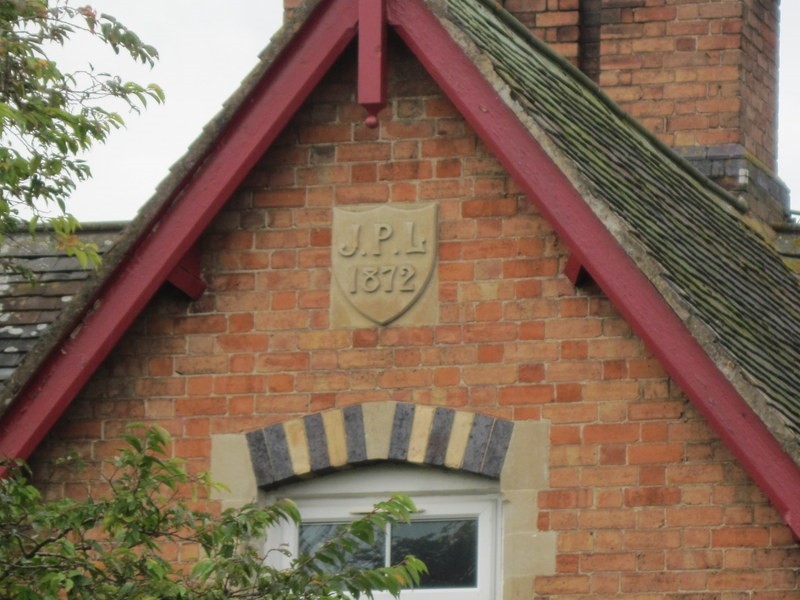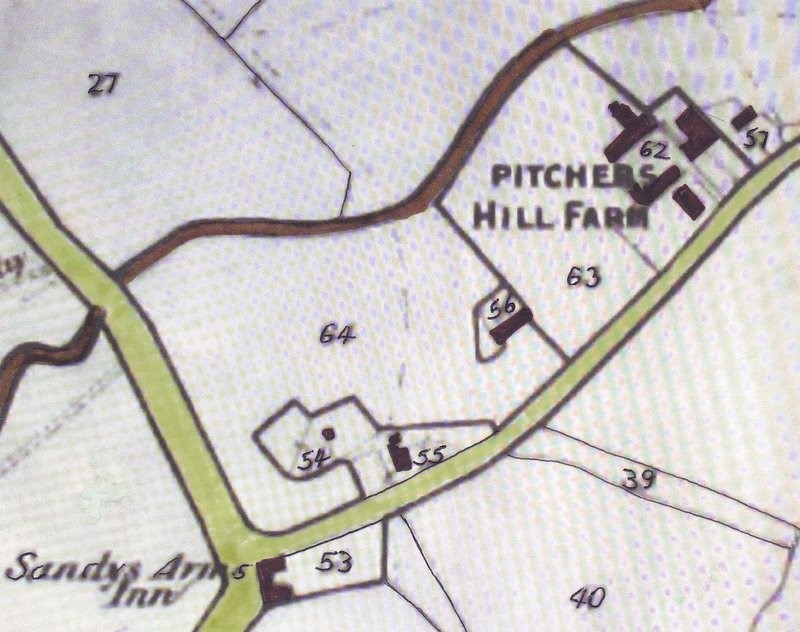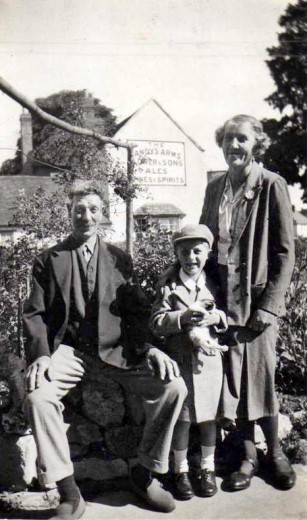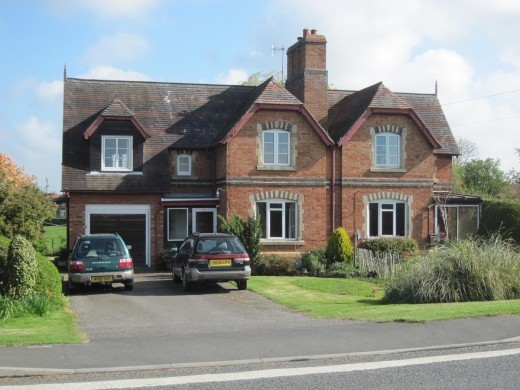
Soon after John Pickup Lord purchased the Wickhamford Estate from the 4th Baron Sandys in 1869, after it failed to sell at Auction, he began demolishing a group of old cottages at the junction of the village street and the Evesham to Broadway Road. On this site, he had a pair of brick and tile cottages built and on the side of one there is a plaque giving the date of their completion: 1872.
This article traces the history of the occupation of these cottages from their construction to the present day. (For simplicity, as the addresses of the cottages were recorded differently at various time, they are referred to by their current numbering as ‘No 5’ and ‘No 6’ in this article).

* * * * *
Census of 1871
There were seven families in the cottages that were shortly to be demolished, those of William Wilkins, John Faulkener, Samuel Wheatly, Samuel Stanford, John Glover, William Glover and William Clinton. These families totalled 25 people, but none of them seem to have ever been tenants of the new cottages about to be built.
Census of 1881
In this census, each of the properties now listed as 5 and 6 Longdon Hill, are described by the enumerator as ‘cottage situate in village street’. In the present No 5, was the family of Decimus Agg, whom the enumerator called ‘Deciamus Agge’. He had been born in Childswickham, was aged 40, and worked as an agricultural labourer. His wife, Mary, was born in Mickleton and they had four sons living with them, aged 7 to 15 years. The eldest, named after his father, was a groom. Decimus had two children baptised in Wickhamford in 1872 and 1875, so he may have been the first tenant at the cottage in 1872.
Next door, at the present No 6, lived Israel Davis, a wheelwright, and his wife, Ann; they were aged 49 and 53. He had been born in the village and she in Snowshill, Gloucestershire. He would have worked just across the village street at the Sandys Arms Inn and wheelwright shop.
Census of 1891
At the time of this census, on 5th April, neither cottage was occupied. The Electoral Roll of 1891, lists a Francis ‘Brookes’ as a voter, who had a dwelling house in the village. He may have moved in to No 6 soon after the census and was certainly the tenant in 1901.
Census of 1901
Francis Brooks was aged 45 and had been born in Welland, Worcestershire. His wife, Annie, was the same age, and they had three sons, aged 18 -23, living at home, at No 6. Both father and sons were all recorded as agricultural labourers. Living at the cottage were two lodgers, named Huxley, who were also agricultural labourers.
Next door, at No 5, was 31-year-old John Sandel, a ‘Cattle man on farm’, who was born in Broadway. His wife was Frances and they had four children aged from four months to 12 years. The three youngest children had been born in Childswickham, so the family appear to have only just have moved in to the cottage.
Census of 1911
The tenants of both cottages had changed yet again by 1911. At No 5, lived Herbert George Jones, a 30-year-old carter on a farm, who was born in Abberton, Worcs. His wife, Elizabeth originated in Wiltshire and they had three daughters and a newly born son. The youngest three had been baptised in Wickhamford in 1906, 1908 and October 1910. Also, at the cottage for the census, was lodger, George Witcher, a farm labourer. His age was recorded as 40, but he did not know his place of birth.
At No 6, was James Pitman, aged 40, a farm labourer, and his wife, Alice. Both in their mid-forties, they came from Aston Somerville, Gloucestershire, and had five children aged 7 to 23, the youngest two being born in Wickhamford. James seems to have been illiterate as a census form was completed by one of his sons, on his behalf. Two sons, Wilfred Charles and John Thomas, later served in the Great War, in the Worcestershire Regiment and Labour Corps respectively.
Valuation Survey of 1913
A Valuation Survey was carried out in England and Wales in the years 1910 to 1915 by the Board of Inland Revenue. The cottages being considered here were visited on 11th February 1913 and their size and condition assessed. At this time they were part of the holdings of Benjamin Carter of Field Farm, but still owned the J.P.Lord Trustees. At this time neither cottage was occupied, but for the first time a description of the cottages was written down. They were a pair of brick and tile cottages in poor repair. Each consisted of a living room, a back kitchen and three bedrooms, one being small and situated over the kitchen. There was a privy. The total area of the grounds of the pair of cottages was measured as 0 acres 0 roods 35 perches (1058 sq. yards).
Census of 1921
After the Great War, the census was held in June 1921. ‘5 Wickhamford’, as No 5 was recorded, was occupied by the Southern family. Charles Henry Southern, aged 55, was a garden labourer. He was employed by market gardener, Francois Paul Peelman, in Badsey. His wife was Maria and they had no less than ten children living with them in this three-bedroomed cottage. They were aged from 21 to the youngest, who was not yet two years old – she was the only one born in Wickhamford. The elder sons’ occupations and employers were recorded in this census. Henry (21) was a garden labourer employed by Benjamin Swift in Wickhamford; Ernest (19) was also a garden labourer, working for Williams Guy Snell in the village; Frederick (18) was a baker’s assistant at J. Brewer & Sons of Badsey; John (16) was a farm labourer at Benjamin Carter’s Pitchers Hill Farm; Clarence (14) delivered milk for farmer John Mason of Elm Farm. Four younger children attended Badsey School. All of this family were living in 3 bedrooms.
For this census, the cottage next door was unoccupied. Were some of the Southern family using this space?
During the Second World war, the Evesham Standard reported that eight of Maria Southern’s sons and sons-in-law were serving their country. Four were in the Army, one in the R.A.F. and three in the Home Guard. By this time, the family had moved to Pitchers Hill.
Electoral Roll of 1924
The Southern family had moved on by 1924, when the Electoral Roll showed two new families in occupation at 5 & 6 Longdon Hill. At No 5, the voters were three members of the Broadhurst family – George Edward, George Herbert and Edith. Women over 30 years of age could vote in 1924. Nothing is known of this family in Wickhamford and Badsey, apart from the Electoral Roll and that a son, John, born in 1914, attended Badsey School from 1922 to 1926, when he left the district. The Broadhursts seem to have come from Honeybourne, as this a recorded as John’s previous school before 1922.
At No 6, were four voters in the Figgitt family – Hubert and Emily Jane, and sons, William John and Albert Walter. Emily Jane Figgitt was buried in Wickhamford in 1926, aged 57 years. Albert Walter Figgitt died aged only 33 and was buried in 1928. (Thomas) Hubert Figgitt died in 1936, aged 72.
William John Tustin Figgitt, to give him his full name, born in 1892, had served in the Great War in the Labour Corps, being unfit for active service. He died in 1965. His brother, Albert Walter Figgitt also served, as a mechanic, in the Royal Flying Corps in 1918 after earlier being in an Employment Company, involved in salvage work.
The Sale of the Wickhamford Estate in 1930
When the J.P.Lord Trustees put up the Wickhamford Estate for sale in 85 lots in September 1930, the cottages at 5 & 6 Longdon Hill were not mentioned. At the 1913 Valuation Survey they were still owned by the Trustees, who subsequently sold the cottages. In 1922, Pitchers Hill Farm was sold by the Executors of the late William Smith, who had bought the farm from the Trustees at some time between 1913 and 1921. It was bought by Ella Margaret Carter of Northumberland and she placed a relative, Albert Edward Carter, in charge of the property. It is likely that the pair of cottages built in 1872 were included in this arrangement and some of the farm workers lived there.
Early 1930s
In the early 1930s, 5 Longdon Hill was occupied by Clifford Emmanuel Thomas Merrick Summers, his wife, Edith Annie Elizabeth (nee Surman) and about seven children. They had moved to Wickhamford from Pershore in May 1927, when their eldest son, Ernest, enrolled at Badsey School. Clifford Summers was a farm labourer and milked the cows at Field Farm until dermatitis prevented him milking. He then operated Wickhamford Mill until it stopped working in the late 1930s. He was also the groundsman for Wickhamford F.C. In 1930, one of his children, Ronald Summers, aged four, was killed in a tragic accident outside of Badsey School. The family had moved to 14 Council Cottages, Pitchers Hill by the end of 1939, when they had seven children living at home.
The Register of 1939

At the outbreak of the Second world War, a Register of all inhabitants of the country was drawn up in September 1939. Both cottages were occupied by members of the Spragg family. At what was called ‘5 Evesham Road’, were William and Edith Spragg with two children and a lodger, Albert Stephens. William Spragg was born in 1905 and in 1939 was a cowman. He worked at Pitchers Hill Farm. Stephens was a market gardener’s labourer.
Next door, at ‘6 Evesham Road’ was an older couple, John and Elizabeth Spragg, born in the early 1880s. He was working as farm labourer involving a dairy, probably also at Pitchers Hill farm. This couple had two lodgers – Martin Crump, a farm labourer and Nellie Horne, doing unpaid domestic duties. John Spragg had joined the Grenadier Guards in 1915 – he was over 6ft tall – but discharged, after only 88 days, because of lumbago. He then joined the Royal Defence Corps. He had moved to Wickhamford in 1938 to work for Edward Carter at Pitchers Hill Farm, milking cows.
In the 1930s, the cottages were extended at the rear to provide downstairs bathrooms and outside toilets.
Post Second World War

When the cottages were built in 1872 their frontage was to the main road from Evesham to Broadway, which had a sharp bend just along the road at the Sandys Arms. The main road, now the A44, was straightened in 1958 and the cottages at 5 & 6 Longdon Hill were by-passed at this time.
In 1947, Pitchers Hill Farm, including 5 Longdon Hill, was tenanted to Leslie Poulter, who lived at The Drifford, Murcot Turn. This cottage was known as ‘cowman’s cottage’, as it was occupied by William Spragg, who was the sole worker at the 38 acre farm, looking after six cows, two cart horses and a few pigs. Next door, 6 Longdon Hill belonged to Mill House Farm, which had been created in the 1930s, when 70 acres was split off from Pitchers Hill Farm and added to Wickhamford Mill.
In about 1948/49, William Spragg moved to No 6 and went to work, as a cowman, for Austin Daffurn at Mill House Farm. He was succeeded at No 5 by Derek Waterfield and his wife, and he was employed by Leslie Poulter, as a cowman, when his dairy herd was increased to 20 Shorthorn cows.
In 1952, Pitchers Hill Farm, including 5 Longdon Hill, was bought by Leslie Poulter. The main house, by the farm buildings was sold on to Mr & Mrs Ted Parry. This house was renamed ‘Wickham House’ and the farm name was changed at the same time, to Wickham Farm. At about this time, Stan Oliver and his family moved into 5 Longdon Hill, when he replaced Derek Waterfield as the cowman.
In 1956, Stan Oliver moved to Field Farm, Longdon Hill, when Leslie Poulter’s son, Gerard, came home from Harper Adams College and took on the milking at Pitchers Hill Farm. He continued with that work until 2016, when the dairy herd was sold.
Other occupants for a short while in the 1950s, were Wally and Pat Stanley, who took in farm students, when they were at 5 Longdon Hill. They were the publicans at the ‘Sandys Arms’, from 1972 onwards, for some years.
The 1960s onwards
In 1964, 6 Longdon Hill was sold to Mrs Everitt, who lived there until her death in 1973. She gave it the name it has at present – ‘Jasmine Cottage’. The plant grew profusely by the front door. In 1965, 5 Longdon Hill was extended by enlarging the kitchen, adding a utility room and porch; gas central heating was also installed. In 1967, it became the first house in the S.W. Gas Region to be converted to North Sea Natural Gas.
In 1966, Gerard Poulter moved in to No 5 and he hosted farm students until 1970, when he married Anne Hirst of Huddersfield. Their children, Giles and Jessica, were born in 1973 and 1976 and an extra bedroom was constructed over the garage. By this time the cottage had been named ‘Green Pastures’. After Giles Poulter married Alison Green, they lived at 6 Longdon Hill, until 2012.
Gerald Poulter was a Churchwarden at the Church of St John the Baptist for 32 years and, for eight years, Chairman of the Committee of Wickhamford Memorial Hall. He installed the first solar panels in Wickhamford in 2012. Anne Poulter was a teacher at Chipping Campden School and later a teacher’s assistant at Badsey School for over 20 years. She was a founder member of Wickhamford Play School, and Beaver and Cub leader for Badsey for over 40 years. For these endeavours, she was awarded the Badsey Society’s Tony Jerram Award in 2019.
Of the 150 years that the Longdon Hill cottages have been in existence, the Poulters have lived in No 5 for over one third of that time.
Architectural features
The builder of the cottages, in 1872, used certain architectural features in their construction, which were used in a few other properties in the district, including the pair of cottages built for J P Lord at the Evesham end of Wickhamford Lane.
There are stone surrounds to the windows, a string of blue and yellow bricks around the middle of the cottages between the ground floor and first floor, and decorative gable ends with shaped posts at the end of each roof ridge. There are also strings of five blue and three orange roof tiles, with the ridge tiles having a tabular top. These features were replicated when ‘Green Pastures’ had a bedroom added in about 1976. The 19 tiles need to complete the roof line were sourced from a small stack of exactly that number found in a clump of nettles at the tile-making factory in Ironbridge, Shropshire!
Tom Locke – April 2022
Acknowledgement
Thanks are due to Gerard Poulter, of 5 Longdon Hill, for the information on the architectural features of the properties and for details of the post-WW2 occupants.
